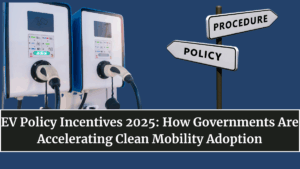As the world transitions toward sustainable mobility, EV policy incentives 2025 are playing a central role in accelerating electric vehicle adoption. From tax benefits and purchase subsidies to infrastructure expansion, governments around the globe are implementing strong initiatives to make electric mobility accessible and affordable for all. These policies are not only reshaping the auto market but also helping nations meet their net-zero emission goals faster.

Global Push Toward Electric Mobility
Governments worldwide are embracing electrification as the future of transport, with 2025 serving as a key milestone year. Countries like India, the UK, the US, and Germany are introducing ambitious programs to boost EV production, sales, and charging infrastructure.
For instance:
-
India’s FAME-II scheme offers direct subsidies for electric two-wheelers, cars, and buses.
-
The US Inflation Reduction Act (IRA) provides up to $7,500 in EV tax credits for eligible vehicles.
-
The UK’s OZEV program continues to expand charging access across residential and commercial zones.
-
Germany and Norway lead Europe in purchase incentives, toll exemptions, and tax reductions.
Together, these initiatives create a powerful push for manufacturers and consumers to shift away from fossil-fuel vehicles.
Tax Breaks and Purchase Subsidies
One of the biggest drivers of EV adoption is financial incentive programs that make electric vehicles more affordable. Many countries now provide:
-
Direct purchase subsidies (cash rebates for buyers)
-
Tax exemptions or credits (reduction in import or registration taxes)
-
Scrappage incentives (trade-in benefits for replacing old petrol vehicles)
-
Corporate fleet benefits (tax deductions for EV fleet conversions)
For example, India offers incentives of up to ₹1.5 lakh on electric four-wheelers, while China’s subsidies focus on battery range and efficiency benchmarks. These financial tools are encouraging millions to choose electric vehicles over traditional models.
Infrastructure Development and Charging Expansion
In 2025, governments are heavily investing in EV charging infrastructure — a critical element of policy success. Nationwide networks of fast-charging stations are being established to ensure convenience and reduce range anxiety.
-
India aims to install one charging station every 3 km in major cities.
-
The European Union mandates charging stations every 60 km on highways.
-
The US is funding the creation of 500,000 charging stations through the National Electric Vehicle Infrastructure (NEVI) plan.
Moreover, integration with renewable energy sources such as solar and wind ensures that clean vehicles run on truly clean power.
Policy Incentives for Manufacturers and Businesses
Governments are not just targeting consumers — they are incentivizing EV manufacturers, battery makers, and startups as well. These include:
-
Production-linked incentives (PLIs) for EV and battery manufacturing in India.
-
Low-interest loans and tax holidays for green tech startups.
-
Research and development grants for innovations in charging, recycling, and smart mobility.
-
Fleet electrification mandates for logistics and public transport companies.
Such policies encourage industrial growth while fostering innovation in AI, battery recycling, and autonomous mobility solutions.
The Economic and Environmental Impact
The impact of these EV policy incentives is far-reaching. On one hand, they are creating millions of jobs in green manufacturing and infrastructure. On the other, they’re significantly reducing carbon emissions and oil imports.
For instance, India’s adoption of EVs under the FAME scheme is expected to save nearly 7.5 billion liters of fuel annually. Similarly, the US and EU projects show a 30–40% drop in transportation-related CO₂ emissions by 2030. These policies are laying the foundation for a clean, resilient, and self-sufficient energy ecosystem.
The Road Ahead
By 2025, EV policy frameworks are becoming more integrated — combining incentives for consumers, industries, and urban infrastructure. Governments are now focusing on interoperable charging networks, digital energy tracking, and vehicle-to-grid (V2G) systems.
As EV policy incentives 2025 continue to evolve, the world moves closer to a new era where clean mobility is not just an option but the norm. The next phase will be about scaling adoption beyond cities — ensuring electric mobility reaches every home, highway, and fleet.
FAQs
What are EV policy incentives?
They are government measures like tax breaks, subsidies, and grants designed to make electric vehicles more affordable and accessible.
Which countries offer the best EV incentives in 2025?
India, the US, Norway, the UK, Germany, and China lead in EV subsidies, infrastructure funding, and production incentives.
How do these incentives help consumers?
They reduce the purchase cost of EVs, make charging more accessible, and support lower running costs through rebates and exemptions.
Do businesses also benefit from EV policies?
Yes. Many governments offer corporate tax benefits, PLI schemes, and fleet electrification grants to promote large-scale EV adoption.
What’s the future of EV policy incentives?
Expect more integration with renewable energy, digital grids, and autonomous transport, ensuring long-term sustainability and scalability.
